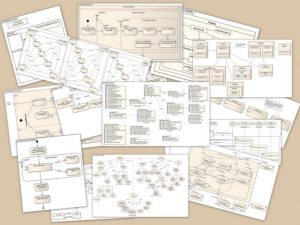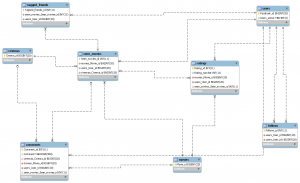Dragon’s Den Pitch Overview
Last week our team presented MovieIt social network-based recommendation application on the Dragon’s Den Pitch panel. We ran 10 minutes presentation that introduced key features of our system outlining technical, social, legal and economic aspects. After presentation “dragons” addressed to us multiple questions pointing out some “gaps” in our project. We found this critics and notes very useful in terms of future idea and marketing strategy evolvement. Below are presentation slides and a short overview of some asked questions and provided answers.
Hacking Social Networks APIs… the MovieIT way
 Javascript based Facebook login OAuth 2.0
Javascript based Facebook login OAuth 2.0
One of the positive features of OAuth 2.0 is that the OAuth dance occurs only by using HTTP GET method. This code resides in the Auth.htm page. The if structure checks the browser URL to identify the current step and move to the next one. The first step is to access the https://www.facebook.com/dialog/oauth by providing the application id, the redirection URI and the response type (which in our case is of type token). In our case we set the redirection address to again to the Auth.htm file. After the successful redirection from the Facebook page the script makes again a HTTP GET request to the same endpoint by providing the application ID, redirect URL, the response type and the resources that this application will have access to. If everything goes well then Facebook redirects the browser to back to the Auth.htm page by providing a code parameter. The final part of the script extracts this information for the url and passes it to our servlet in order to provide a customized to the user homepage (e.g. his profile image etc.). Read the rest of this entry »
The MovieIT system in UML (updated)
 Use case diagram
Use case diagram
Login
The system requires the Facebook authentication of the user in order to function. For this reason when the user accesses the page is redirected to Facebook web page to provide his/her credentials and then, is redirected back to the main page of the application. The authentication “dance” between the client and Facebook is shown in the following image.
Check In
In the check in use case the user selects the place he wants to check in, the movie he watched and the friends he watched the movie with. The system finds the trailer of the movie selected and posts the check in information both to Facebook and Twitter. Read the rest of this entry »
MovieIt Usability Evaluation
 Last advances in mobile technologies and rapid spread of 3G networks engaged handsets with the Web bringing an instance access to online resources from any place and at any time. However, facilities of mobile devices are not equal to PC (lower screen resolution, performance issues, diversity in geometry of the display and buttons arrangement, etc.) what significantly spoils the user experience. Thus, building a web-based app we need to keep in mind this specific and follow usability rules. In this post we will examine MovieIt in terms of its usability comparing core system characteristics with mobile usability check lists.
Last advances in mobile technologies and rapid spread of 3G networks engaged handsets with the Web bringing an instance access to online resources from any place and at any time. However, facilities of mobile devices are not equal to PC (lower screen resolution, performance issues, diversity in geometry of the display and buttons arrangement, etc.) what significantly spoils the user experience. Thus, building a web-based app we need to keep in mind this specific and follow usability rules. In this post we will examine MovieIt in terms of its usability comparing core system characteristics with mobile usability check lists.
MovieIt Demo Video
http://www.youtube.com/watch?v=38J51UXtRo0
Working Demo link!
kanga-et2e10.ecs.soton.ac.uk/Movies/Auth.htm (Accessible only from ECS)
MovieIt and Legal Aspects
 The Web 2.0 content can be categorized as a user generated content (UGC) where anyone can say anything about anything. This decentralization of information publishing boosted even more intensive spread of WWW and attracted huge amount of people that generate millions of pages, records, images, videos and other multimedia content every day. Along with obvious advantages (diverse and rich content, availability of discussion platforms, etc.) social Web exposed some serious legal issues related to copyright infringements or publishing of false and detractive information about facts, individuals or legal entities. However, it would not be true to say that legal issues in the Web appeared with the movement to UGC model. Plagiarism and libel existed long before WWW invention but due to the decentralized nature of the Web 2.0 and a huge amount of generated content they became less controllable and, thus, more common. Another issue with a social content is that the majority of users does not consider online publishing as something serious and feel less responsible for the exposed web content. For example, the survey held by YouGov in 2008 revealed that “three quarters of Internet users who comment online realize they could be breaking the libel law”.
The Web 2.0 content can be categorized as a user generated content (UGC) where anyone can say anything about anything. This decentralization of information publishing boosted even more intensive spread of WWW and attracted huge amount of people that generate millions of pages, records, images, videos and other multimedia content every day. Along with obvious advantages (diverse and rich content, availability of discussion platforms, etc.) social Web exposed some serious legal issues related to copyright infringements or publishing of false and detractive information about facts, individuals or legal entities. However, it would not be true to say that legal issues in the Web appeared with the movement to UGC model. Plagiarism and libel existed long before WWW invention but due to the decentralized nature of the Web 2.0 and a huge amount of generated content they became less controllable and, thus, more common. Another issue with a social content is that the majority of users does not consider online publishing as something serious and feel less responsible for the exposed web content. For example, the survey held by YouGov in 2008 revealed that “three quarters of Internet users who comment online realize they could be breaking the libel law”.
It’s all about data!
Database managment is an important of the aspects of the MovieIt project. The following diagram displays the structure of our relational database, along with the conenctions between them.


